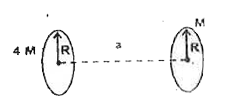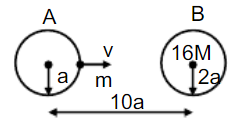Distance between the centres of two stars is . The masses of these stars are and and their radii a and respectively. A body of mass is fired straight from the surface of the larger star towards the surface of the smaller star. What should be its minimum initial speed to reach the surface of the smaller star? Obtain the expression in terms of , and a.
The correct Answer is:A, B, C, D
To solve the problem, we need to determine the minimum initial speed required for a body of mass m to reach the surface of the smaller star from the surface of the larger star. We will use the concept of gravitational potential energy and conservation of energy.
1. Identify the Parameters:
- Mass of the larger star, M1=16M
- Radius of the larger star, R1=2a
- Mass of the smaller star, M2=M
- Radius of the smaller star, R2=a
- Distance between the centers of the two stars, d=10a
2. Calculate the Distance from the Surface of the Larger Star to the Smaller Star:
- The distance from the surface of the larger star to the center of the smaller star is:
d−R1−R2=10a−2a−a=7a
- Thus, the distance from the surface of the larger star to the center of the smaller star is 7a.
3. Determine the Point Where Gravitational Forces Balance:
- Let r1 be the distance from the center of the larger star to the point where the gravitational forces from both stars balance, and r2 be the distance from the center of the smaller star to that point.
- From the problem, we have:
r1+r2=10a
- The gravitational fields at that point due to both stars must be equal:
GM1r21=GM2r22
- Substituting M1=16M and M2=M:
16GMr21=GMr22
- This simplifies to:
r2=4r1
4. Substituting into the Distance Equation:
- From r1+r2=10a:
r1+4r1=10a⟹5r1=10a⟹r1=2a
- Therefore, r2=4r1=8a.
5. Calculate the Potential Energies:
- The potential energy of the mass m at the surface of the larger star is:
PE1=−GM1mR1=−16GmM2a=−8GmMa
- The potential energy at point P (where m is at distance 7a from the larger star and 2a from the smaller star) is:
PEP=−GM1m7a−GM2m2a=−16GmM7a−GmM2a
- Finding a common denominator (14a):
PEP=−32GmM14a−7GmM14a=−39GmM14a
6. Apply Conservation of Energy:
- The total mechanical energy at the surface of the larger star (initial) equals the total mechanical energy at point P (final):
12mv2+PE1=PEP
- Substituting the potential energies:
12mv2−8GmMa=−39GmM14a
- Rearranging gives:
12mv2=−39GmM14a+8GmMa
- Finding a common denominator:
12mv2=−39GmM14a+112GmM14a=73GmM14a
- Thus:
mv2=146GmM14a⟹v2=146GM14a
- Finally, taking the square root gives:
v=√73GM7a
Final Expression:
The minimum initial speed v required for the body of mass m to reach the surface of the smaller star is:
v=√73GM7a
- Mass of the larger star, M1=16M
- Radius of the larger star, R1=2a
- Mass of the smaller star, M2=M
- Radius of the smaller star, R2=a
- Distance between the centers of the two stars, d=10a
- The distance from the surface of the larger star to the center of the smaller star is:
d−R1−R2=10a−2a−a=7a
- Thus, the distance from the surface of the larger star to the center of the smaller star is 7a.
- Let r1 be the distance from the center of the larger star to the point where the gravitational forces from both stars balance, and r2 be the distance from the center of the smaller star to that point.
- From the problem, we have:
r1+r2=10a
- The gravitational fields at that point due to both stars must be equal:
GM1r21=GM2r22
- Substituting M1=16M and M2=M:
16GMr21=GMr22
- This simplifies to:
r2=4r1
- From r1+r2=10a:
r1+4r1=10a⟹5r1=10a⟹r1=2a
- Therefore, r2=4r1=8a.
- The potential energy of the mass m at the surface of the larger star is:
PE1=−GM1mR1=−16GmM2a=−8GmMa
- The potential energy at point P (where m is at distance 7a from the larger star and 2a from the smaller star) is:
PEP=−GM1m7a−GM2m2a=−16GmM7a−GmM2a
- Finding a common denominator (14a):
PEP=−32GmM14a−7GmM14a=−39GmM14a
- The total mechanical energy at the surface of the larger star (initial) equals the total mechanical energy at point P (final):
12mv2+PE1=PEP
- Substituting the potential energies:
12mv2−8GmMa=−39GmM14a
- Rearranging gives:
12mv2=−39GmM14a+8GmMa
- Finding a common denominator:
12mv2=−39GmM14a+112GmM14a=73GmM14a
- Thus:
mv2=146GmM14a⟹v2=146GM14a
- Finally, taking the square root gives:
v=√73GM7a
The minimum initial speed v required for the body of mass m to reach the surface of the smaller star is:
v=√73GM7a
Topper's Solved these Questions
- GRAVITATIONBook:DC PANDEY ENGLISHChapter:GRAVITATIONExercise:Miscellaneous Examples
Explore 8 Videos
- GRAVITATIONBook:DC PANDEY ENGLISHChapter:GRAVITATIONExercise:Exercise 13.1
Explore 5 Videos
- GRAVITATIONBook:DC PANDEY ENGLISHChapter:GRAVITATIONExercise:(C) Chapter Exercises
Explore 45 Videos
- GENERAL PHYSICSBook:DC PANDEY ENGLISHChapter:GENERAL PHYSICSExercise:INTEGER_TYPE
Explore 2 Videos
- KINEMATICSBook:DC PANDEY ENGLISHChapter:KINEMATICSExercise:INTEGER_TYPE
Explore 10 Videos
Similar Questions
Distance between the centres of two rings is a. The masses of these rings are M and 4M. A body of mass m is fired straight from the centre of the heavier ring. What should be its minimum initial speed to cross of lighter ring ? The radius of the both ring is R. (Assume a>>R).

View SolutionWhat is the source of energy of sun or stars ?
View SolutionTwo planets have masses M and 16 M and their radii are a and 2a, respectively. The separation between the centres of the planets is 10a. A body of mass m is fired trom the surface of the larger planet towards the samller planet along the line joining their centres. For the body to be able to reach at the surface of smaller planet, the minimum firing speed needed is :
View SolutionStar Fish is
View SolutionStar Fish is
View SolutionSea Star is
View Solution
Two planets of mass M and 16M of radius a and 2a respectively, are at distance 10a. Find minimum speed of a particle of mass m at surface of smaller planet so that it can reached from smaller planet to larger planet.
View SolutionThe radiation emitted by a star A is 10,000 times that of the sun. If the surface temperatures of the sun and the star A are 6000 K and 2000 K respectively, the ratio of the radii of the star A and the sun is
View SolutionThe radiation emitted by a star A is 10,000 times that of the sun. If the surface temperatures of the sun and the star A are 8000 K and 2000 K respectively. The ratio of the radii of the star A and the sun is
View SolutionAlpha Centauri, our nearest star, is at a distance of
View Solution
